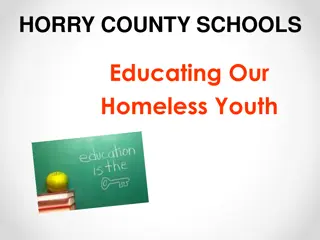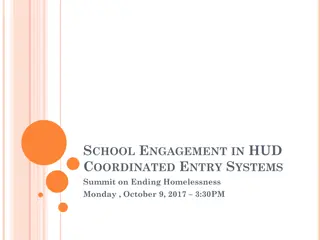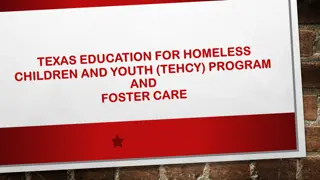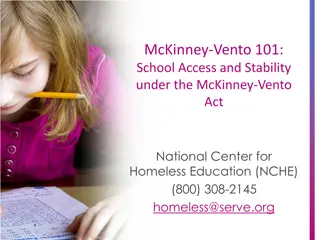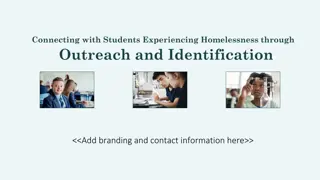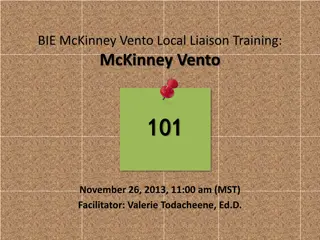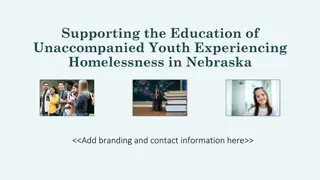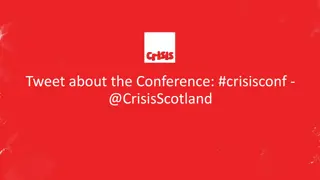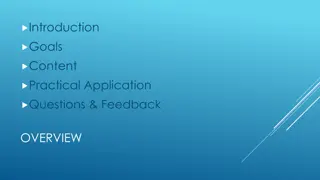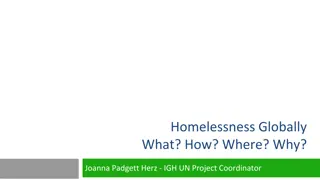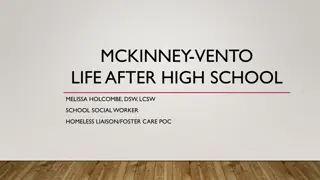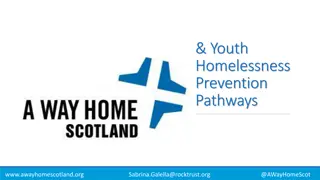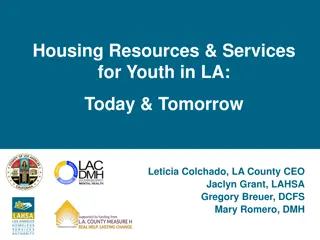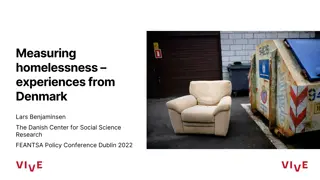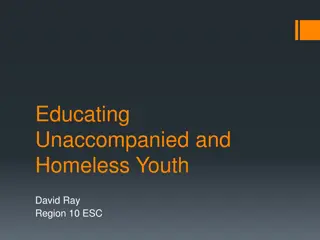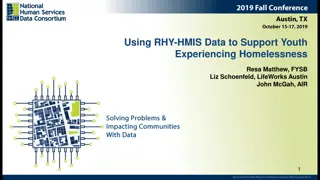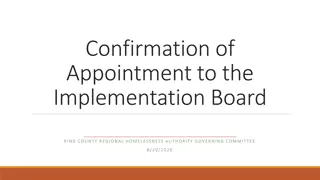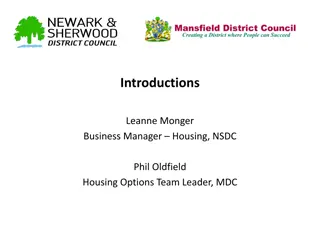Understanding McKinney-Vento Act and Homelessness Among Youth
Explore the McKinney-Vento Act and its impact on homeless youth. Learn about the challenges faced by students experiencing housing instability and examples of young people in such situations. Understand the definition of homelessness under the Act and the concept of unaccompanied youth in educational settings.
Download Presentation

Please find below an Image/Link to download the presentation.
The content on the website is provided AS IS for your information and personal use only. It may not be sold, licensed, or shared on other websites without obtaining consent from the author. Download presentation by click this link. If you encounter any issues during the download, it is possible that the publisher has removed the file from their server.
E N D
Presentation Transcript
Rochester City School District Families In Transition-FIT Program Greta M. Davis, MSEd, LCSW- R, CASAC II McKinney Vento Homeless Assistance Act: Education & Homeless Youth Wednesday, March 17, 2021
Objectives: Overview of Families In Transition, FIT Program: McKinney Vento Act, Education & Housing Instability Current trends in service delivery: Needs and challenges currently in serving students experiencing housing instability: Opportunities to collaborate with others in the community:
Examples of Young People Experiencing Homelessness: Anastasia sleeps on her friends couch and borrows her friends clothes to wear to school. Her dad kicked her and her mom out of the house after a fight that turned physical. She s unsure where her mom is staying, but her mom assures Anastasia that she is fine. Diego lives with his parents and his dog in a bedroom illegally subleased to them by other renters after his parents lost their suburban home due to a job layoff and illness. He hides his dog when the landlord comes around because pets are not allowed. Fredrick lives with his two brothers, one sister, and mom in a motel room after a bad storm three moths ago made their old house unlivable. He attends high school in a different school district because the storm also destroyed his old school. Fredrick worries about what will happen to his family because his mom s place of work has not reopened following the storm. American Educator- Spring 2021
McKinney-Vento Act Definition of homelessness: The term homeless children and youth A. means individuals who lack a fixed, regular, and adequate nighttime residence ; and B. includes children and youths who are sharing the housing of other persons due to loss of housing, economic hardship, or a similar reason; are living in motels, hotels, trailer parks, or camping grounds due to the lack of alternative adequate accommodations; are living in emergency or transitional shelters; or are abandoned in hospitals; children and youths who have a primary nighttime residence that is a public or private place not designed for or ordinarily used as a regular sleeping accommodation for human beings ; children and youths who are living in cars, parks, public spaces, abandoned buildings, substandard housing, bus or train stations, or similar settings; and migratory children who qualify as homeless for the purposes of this subtitle because the children are living in circumstances described in clauses (i) through (iii).
Unaccompanied Youth: Youth that are not in the physical care and custody of their parent. The McKinney-Vento Act includes no program-specific age requirements to qualify as an unaccompanied homeless youth. If a youth is eligible for K-12 (ages 3-21) public education in the state, he or she will be enrolled and served as an unaccompanied homeless youth. Unaccompanied youth DO NOT need parent s permission to enroll in school and should be enrolled immediately.
Every Student Succeed Act, ESSA States that students have the following rights: Homeless students have the right to continue attendance in their school of origin, and under the new definition, a school of origin includes preschool. A student who moves into permanent housing is entitled to continued transportation for the remainder of the academic year. There are increased privacy protections for address and housing information for students in temporary housing. Information about the living situation of a student who is homeless is part of the student s record, subject to the protections of the Family Educational Rights and Privacy Act (FERPA). Liaisons must notify unaccompanied youth of their eligibility for independent student status for the Free Application for Federal Student Aid (FAFSA).
Students Educational Rights Immediate enrollment in school without the burden of providing proof of residency, immunizations, school records, or other documents typically needed for enrollment. Transportation (no minimum mileage requirement-up to 50 miles one way) Choice of School of Origin or School Where Temporarily Housed Automatically Qualify For Food Services Emergency Clothing & School Supplies Participate Fully in Educational Support Services & Extra- Curricular Activities
Absences The McKinney-Vento Act requires schools to identify and remove all barriers to enrollment and retention in school for children and youth in homeless situations. 42 U.S.C 11432(g)(1)(I), (g)(7). Zero tolerance rules for absenteeism can be such barriers, particularly when they result in class failures, exclusion from school, or court involvement. Frequently, students in homeless situations will miss school due to their living situations. Absences caused by homelessness must not be counted against students, as this would create a barrier to enrollment and retention in school. Since the inability to earn any credit is a disincentive to remaining in school, the school must address that problem. The school must make any necessary adjustments to the student s schedule to permit the student to make up local and state exams, obtain partial or prorated credit for his or her work and to participate in credit recovery opportunities.
Facts About Homeless Teens The Department of Justice estimates that every year, over 1.7 million teens experience homelessness in the US. According to estimates by the Urban Institute, nearly 1 in 5 youths under the age of 18 will run away at least once. Approximately 40% of homeless teens identify as LGBTQ+. Family rejection on the basis of sexual orientation and gender identity was the most frequently cited factor contributing to LGBT homelessness (46%). Over 50% of young people in shelters and on the streets report that their parents told them to leave or knew they were leaving and didn't care. About 80% of homeless youth (aged 12-21) use drugs or alcohol as a means to self-medicate to deal with the traumatic experiences and abuse they face. In New York City, one in ten (114,085) youth experienced homelessness during the 2018-19 school year. Young people of color, LGBTQ youth, student education, and pregnant/ parenting teens all disproportionately experience homelessness.
Characteristics Associated with Homeless Students Physical Hunger: saving food from school for home & preoccupation with food Sleep Deprivation: restless, tired & moody Poor Hygiene: disheveled & wearing the same clothes Behavior: non-compliant, shutting down, aggression Social Impaired Social Skills: unable to initiate & maintain healthy peer friendships & socially immature Intermittent Attention to Tasks: daydreaming & heightened distractibility Lost Sense of Security: clingy toward parent, fear of going home , insecure/lack of confidence Emotional Stress: fatigued, preoccupied w/basic needs being met, traumatized, distracted, moody Anxiety: fidgety, inability to focus, moody Grief/Loss: anger, sadness, withdrawal, socially isolated Lethargy: lack of motivation & loss of interest in everyday things Academic Lack of Academic Progress: decreased work quality; incomplete assignments/homework, intermittent attention on tasks, temperamental, lethargic, disinterest in school work,
Rochester City School Districts Families In Transition, FIT Program The McKinney-Vento-MV Act is the federal law that protects the educational rights of homeless students. First enacted in 1987 because 50% of homeless students were not receiving a proper education. McKinney-Vento Act was reauthorized in 2015, and is now part of the Every Student Succeeds Act, ESSA. RCSD s Families In Transition, FIT Program is the direct result of the McKinney-Vento Act and has been in place since 1997. Trauma Sensitive Approach utilized to meet the needs of students and families recognizing the effects of toxic stress and trauma on the individual and their ability to perform at their optimal level.
Role of McKinney-Vento Liaison Identification Enrollment Referral for Early Childhood Referral for Health, Housing, and Other Needed Services Parent Involvement Posting Public Notice Dispute Resolution Transportation Training for Colleagues Meeting Needs of Unaccompanied Youth
Statistics- Last 5 Years Year 2016-2017 MV STAC 135 Unaccompanied Youth 190 2723 2017-2018 3286 224 110 2018-2019 2880 160 77 *2019-2020 2295 162 53 *2020-2021 706 12 6 *Effects of the National Pandemic STAC: System to Track and Account for Children
Leading Causes of Homelessness: Substandard/Lack of Affordable Housing Reduced Employment Opportunities Loss of Employment Domestic Violence Physical/Mental Illness Substance Abuse Students Ejected From Home Relocation
Elda Lopez Santana, Bilingual Home School Assistant Current Needs and challenges faced by Students and Families Experiencing Housing Instability https://drive.google.com/drive/folders/14UHHf3Iq7JMP5bB19OJXF9M2kNqRfONp?usp=sharing
Hannah Noble, Intern Opportunities to Collaborate with Others in the Community https://drive.google.com/drive/folders/1gfS0aCed8-avBE298LMxUhZPmOaHFrlz?usp=sharing
McKinney-Vento Resources NYS TEACHS Jennifer Pringle, J.D. Project Director, NYS-TEACHS New York State Technical and Education Assistance Center for Homeless Students www.nysteachs.org 151 West 30th Street, 5th Floor New York, NY 10001 NYS-TEACHS Hotline (800) 388-2014 Direct (212) 822-9546 Fax (212) 807-6872 jpringle@advocatesforchildren.org www.advocatesforchildren.org NYSED Melanie P. Faby, Program Associate New York State Education Department Office of Accountability -Title I 89 Washington Avenue, 320 EB Albany, New York 12234 Phone: (518) 473-0295 FAX: (518) 486-1762 E-Mail: melanie.faby@nysed.gov
Staff Contact Information: Gladys Williams, Secretary Gladys.Williams@rcsdk12.org 585-324-9982 Elda Lopez Santana, Bilingual Home School Assistant Elda.Vazquez@rcsdk12.org 585-324-9981 Greta M. Davis, MSEd, LCSW-R, CASAC II McKinney-Vento Liaison Greta.davis@rcsdk12.org 585-324-9983 30 Hart St., Room 122, Rochester NY 14605


